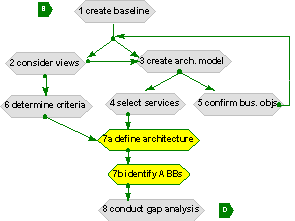7. Complete the architecture definition
Objective Approach Inputs
Activities Outputs
The objective of this step is to fully specify the target architecture. This is a
complex and iterative process in which the selection of building blocks and interfaces has
a big impact on how the original requirements are met. Figure
2 shows this as two boxes, captioned as steps 7a and 7b, but in reality the process is
more complicated. See Part IV, Building Block Example,
for further details.
Completion of the architecture definition may be achieved in two steps, by defining an
intermediate migration architecture in addition to the final target architecture, if
complexity of migration requires it.
The specification of building blocks as a portfolio of services is an evolutionary
process:
- The earliest building block definitions start as relatively abstract ones, defined by
standards and services that map most easily to the architectural framework. These building
blocks are most probably architectural building blocks.
- At this stage a model and a portfolio of services have been established. The next step
is to select the set of specifications that provide the services and that can be combined
as required to create the building blocks.
- During this final step in the development of building blocks it must be verified that
the organization-specific requirements will be met. The development process must include
recognition of dependencies and boundaries for functions and should take account of what
products are available in the marketplace. There are architectural and related solution
oriented building blocks.
- An example of how this might be expressed can be seen in the Building Blocks Example in Part IV. Building blocks can
be defined at a number of levels matching the degree of integration that best defines the
architecture of the system at any stage.
- Fundamental Functionality and Attributes - semantic, unambiguous including security
capability and manageability
- Interfaces - chosen set, supplied (APIs, data formats, protocols, hardware interfaces,
...standards)
- Dependent BBs with required functionality and named used interfaces
- Map to business / organizational entities and policies
- Finally the building blocks become more implementation specific as Solution Building
Blocks and their interfaces become the detailed architecture specification. Solution
Building Blocks are a means to determining how portions of the target architecture might
be procured, developed, or reused. The Solution Building Blocks architecture should have
separate elements for developed, reused and procured building blocks, each described in
terms of their minimum specification.
A full list of standards and specifications recommended by The Open Group can be found
in Part III, Standards Information Base.
The inputs to this step are:
- Business Architecture Version 2
- Technical Architecture Version 0.6
- Re-usable architecture building blocks (from organization's Architecture Continuum, if available)
- TOGAF Standards Information Base
Key activities in this step include:
Ensure clear documentation of all interfaces for each building
block (APIs, data formats, protocols, hardware interfaces).
Select standards for each interface of the architecture building
blocks, reusing as much as possible from TOGAF TRM.
Fully
document each architecture building block.
Final
cross check against business goals.
Document
final requirements traceability reports
Create
final mapping of the architectures within the architecture continuum.
The outputs of this step are:
- Technical Architecture Version 0.7
- Technical Architecture - Technical Architecture Specification
- Technical Architecture - Requirements Traceability
- Technical Architecture - Mapping of the architectures in the architecture continuum.
Step 8: Conduct gap analysis
Copyright � The Open Group, 1998, 1999, 2000, 2001
 Objective
Objective Objective
Objective